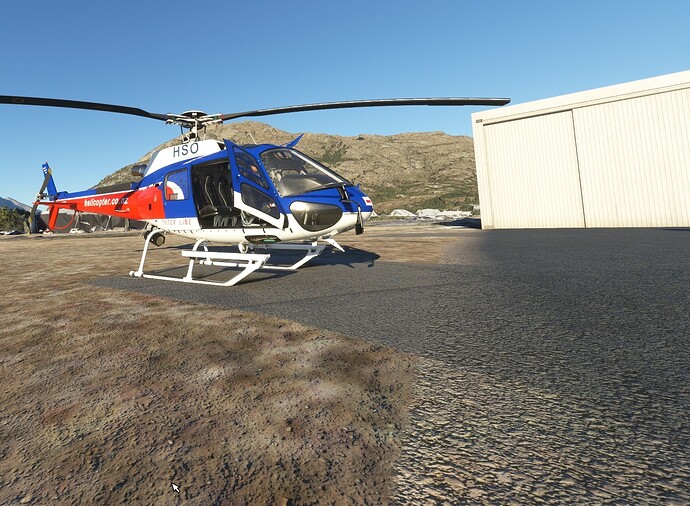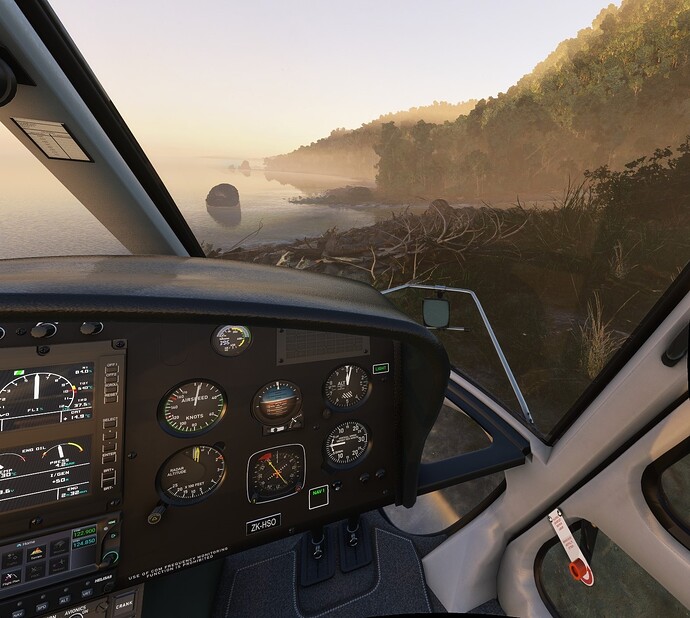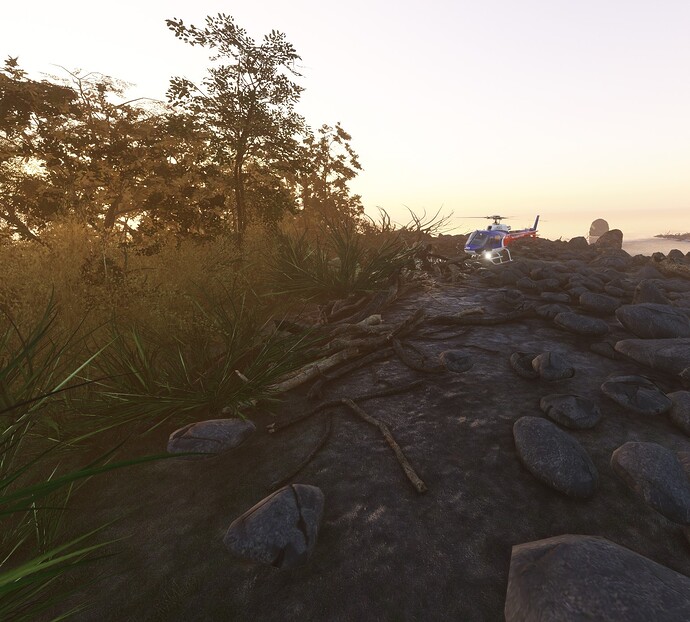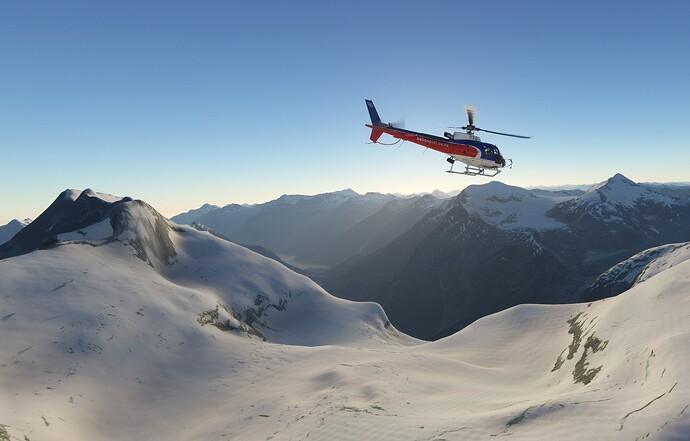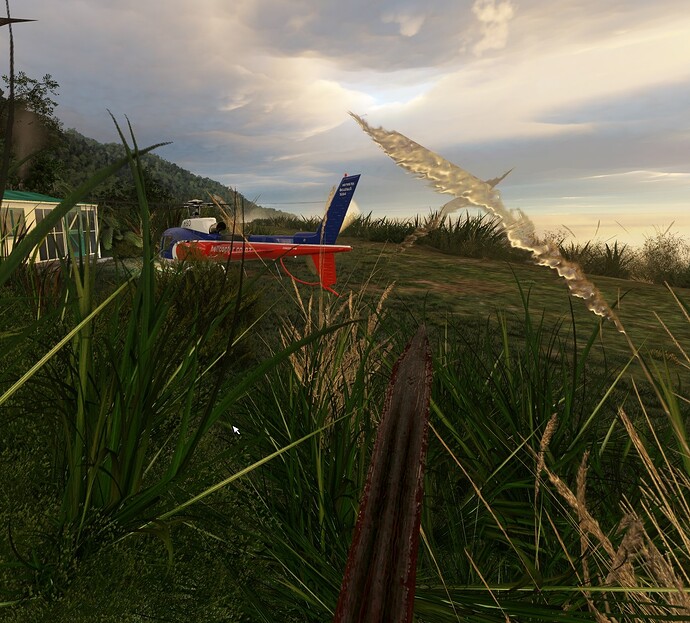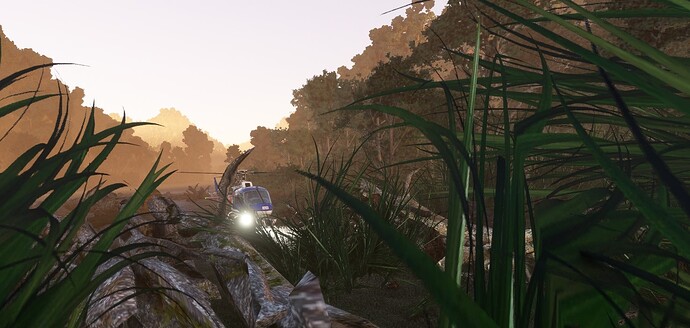Apart from the lack of Force Feedback and force trim, ground behavior is weird. with no collective and pedal input, small cyclic input rolls the B407. And it lands like a rock no matter how gentle you are with the collective decreasing. Landing sound is also crazy. I don’t see such things in the DCS
Great take WolfActual!
Yes, it can be challenging engaging on the forums, that is why I constantly link the Rotorcraft Flying Handbook…
FAA - Helicopter Flying Handbook - Essential Reading
You nailed the ground effect issues. Platform approaches can be tricky due to the unpredictable nature of the ground effect implementation.
Keep making great videos!
Great post!
Dont really understand what you mean when you go from the alouette to the longranger, is both good in very different way but the 407 more realistic?!
And by yanking the cyclic I mean yanking the cyclic! The 407 pulls to the right very fast and hard almost no matter what direction you pull the cyclic, on the xbox controller! And before the update when the tailrotor to the right hardly worked, every pull on the cyclic just spunn it even more to the right.
Like a joke! The mscenery ones still behaves like that!
Its very very easy pulling it 100% in any direction using the stick and this makes it very hard to fly compared to all other chopper, so either the 407 is the best chopper and most realistic in the game or its the worst and least realistic!
This is with collective at fixed position with 40-60%.
And no I dont need more lessons on how to fly helicopters or work around this issue, either its superrealistic or its not.
The cowan choppers do this to but much less and in a manner I would think is more realistic.
Agree on the difference between the Alouette and the Long Ranger. I have not flown the Long Ranger, but I have flown Cowan’s Jet Ranger (206B3). The Alouette’s cyclic, similar to the Lama and H125 is very precise and agile. Just a tiny nudge will instantly move the heli. So the key is to keep the cyclic still and only give tiny inputs when needed to. Going over to the Jet Ranger/Long Ranger, the 2 bladed teetering rotor system means there is a delay between cyclic input and the helicopter’s movement. So now the game changes - you will need to anticipate the movement of the helicopter and give counter/opposing cyclic before hand, which ultimately leads to the “teetering head dance” as mentioned. That is why the Alouette and Long Ranger requires 2 different techniques to fly.
Hi Mate
Yanking on the cyclic is not something you want to use as a test of the fidelity of ANY helicopter in the Sim ![]()
I am sorry that you’re having a bad experience. I hope I can help!
You mention the game controller you are using to control the helicopters in the sim. You are already at a disadvantage from a realism point of view simply due to the interface.
I thought I had read about the mscenery products before so I ran a quick search. A review from helisimmer says it all
Not a great product in any way, shape or form. Unfortunately.
For realism? Right now?
Cowan Sim - Brilliant. About 8/10 in my book. All of their models. Really solid representation for the most part. Any limitations I suspect are more sim-code related and will likely improve even more in the future.
Flyinside - 9/10, using their own, piggyback flight model. Excellent effort and result. If you want to improve with flying helicopters, even in DCS, spend some time on the Bell47! Everything else will improve if you can manage this platform smoothly.
Toag’s Allouette III - 10/10 in the current market. An absolute joy to fly. Awesome textures and sounds only add to the immersion. Love it. A sign of what CAN be done with the intrinsic code in the Sim right now, and that alone is hugely encouraging.
Throw the mscenery product away, practice on the Bell47 and buy the Allouette ![]()
![]()
If you are using a game pad and have any issues, try adjusting the control curves (if you can, on the Xbox version of MSFS?)
Good luck and ask any questions if you have them. Happy to help!
Pics above were taken last night flying from Gorge River, West Coast of the South Island in New Zealand to Queenstown - have almost 500hrs IRL in the AS350BA (not a B3), but the flight model is very good in the low hover (squirrelly ![]() ). A lot of helicopters still have issues with the skid ball and aerodynamic transverse leveling of the fuselage in cruise flight (flying everywhere all the time with one skid hanging low as per the hover). Extremely immersive though. Excellent representation. I can forgive the cruise if the lift, hover, land and maneuver at slow speed is representative
). A lot of helicopters still have issues with the skid ball and aerodynamic transverse leveling of the fuselage in cruise flight (flying everywhere all the time with one skid hanging low as per the hover). Extremely immersive though. Excellent representation. I can forgive the cruise if the lift, hover, land and maneuver at slow speed is representative ![]()
Thanks for all of this, extremely helpful. I’m teetering on the edge of buying my first helicopter in the sim.
That’s awesome. It will open up a whole new level of experience in the sim.
Welcome to the world of Heli simming. Once you get the hang of it, it will be very addictive ![]()
Haven’t bought yet, Bell 47 or the Alouette?
No experience at all.
Personally I would recommend the Allouette. The -47 is jumping in at the deep end. Think of the 47 as the ‘stone to sharpen your blade’ later on.
It does depend a little on what you may want to fly later on. Blackbird’s Huey should be amazing (no pressure Blackbird!) and if that was somewhere you would want to head I would suggest a teetering head. The Cowan B206 jet ranger would be ideal. Then the 47 to sharpen your skills some more. The UH-1 would be an enjoyable breeze after that ![]()
If you want to move to the likes of the EC135 or similar (twin engine helicopters with a lot of assists, more system oriented) go the Allouette, or the Cowan H125 B3 for a start. Note the the B3 is ‘realistically’ squirrelly in the hover; especially below 3’.
The difference between a teetering head and a semi-rigid or fully articulated head is ‘control power’; how much you can influence the attitude of the fuselage through manipulation of the rotor disc via the cyclic. The more solid the interface between the fuselage and the main rotor, the more control power you have, and the more responsive the reactions will be to your inputs. A teetering head is at the lowest end of the control power scale. You ‘fly the main rotor’ whilst dangling from it’s center of rotation in a very expensive gondola! The main rotor is very stable. The fuselage is not. There is consequently a disconnect between your input and the response of the ‘gondola’, thus setting an ‘attitude’ (setting and holding a fixed picture in front and making changes to that picture) becomes so much more important. If you try to fly a teetering head system by reference how you’re moving over the ground, you will induce oscillations and the helicopter in the hover will probably move about in a circle over the ground about as large as the rotor diameter. Like so many things in aviation it comes down to where you look and how you look!
Watch plenty of videos on how everything works. I am planning to produce some tutorials shortly to help people fine tune their lift offs, hovering, slope landings and approaches to land. I find a lot of vids are missing some crucial concepts to make the flying smoother and therefore more enjoyable.
Have fun with it. Start with the simple helicopter flight model but don’t stay there too long. 1-2 flights max. Get into the realistic model and turn crashes off - much better way to learn.
Good luck
Thanks for that, bought the Alouette. Very much looking forward to your tutorials, as I’m sure many others are.
As a matter of interest, in real life, which is harder to learn to fly, the helicopter or the GA aircraft?
First of all, a disclaimer. I am not a real pilot but I have simmed for 25+ years, and the last 15+ years were fully dedicated to helicopters. I have talked to real pilots, wrote about helicopter sims, tried a lot of different products, both in software and hardware, so, while not an actual pilot, I have a lot of experience in the helicopter department of simulation.
Having that said…
Unfortunately, you are right. People do talk about things they don’t know of and they have missconceptions about what things should be.
Add that to the fact that a lot of folks just want to bash the sim and say it’s the same as FSX, and you have an… Interesting mix.
Then we have other elements on top of this. The fact that hardware makes a huge difference in helicopters adds to the mix. But there’s something else that is even trickier and it seems to plague MSFS: not everyone is having the same experience.
While talking to community members (dedicated helicopter pilots), I managed to understand that, sometimes, helicopters behave differently. It’s working in one way to me, another way to others.
Some folks complain about control lag, which I never had but I’ve seen multiple reports. They’re the minority, but they’re there. A person I respect and that I know knows his way around helicopters tried the Alouette and told me he was having a terrible experience. I know it’s not him. I know it’s not the helicopter. I suspect it’s something with the sim.
People don’t seem to understand what MSFS is, what it can do and how good it is. A lot of them don’t understand helicopters, others just want to say it’s as bad as FSX, others don’t care. Then we have those that do understand and care but the hardware doesn’t help.
And then we have those that check all the right boxes but the sim is giving them grief – and we don’t know how to replicate it so that we can tell Asobo.
No sim is perfect. None. Not even DCS as it has its faults. But it’s not fair, nor true, to say MSFS is terrible for helicopters.
If it was, I would not be using it, at all. Right now, it’s becoming my main sim since it’s the most balanced one for me.
Thank you very much for sharing your thoughts with us. I hope it helps other folks out there.
XboxMonkey,
honestly, if you’re new to both, learning is learning - driven more by an individuals capacity TomTom learn than it is by the platform of choice. Passion is such an important ingredient is learning that my advice would be ‘choose the platform you are most passionate about’.
Financially it can be cheaper to start with fixed wing, then credit a portion of those hours across to rotary. How many hours depends on the country and the system they follow, but fixed wing hours are much cheaper to buy than Rotary wing hours.
Spac3Rat
Hi mate. Really valid points. Just a theory but I suspect it has everything to do with frame rates.
When DCS went to multithread recently, the difference was phenominal! All of my flying is in VR with the Varjo Aero. I could easily take the headset VR from 35pp to 39pp - and what a difference!!
I dropped back into MSFS. The headset was still on 39pp, I was trying the Cowan H125 for the first time and, whilst everything looked great, it was completely unflyable. NOT the products fault.
Back to 35pp in the headset, completely flyable. Conclusion, small frame rate variations have a massive effect regards control input sampling.
This was further highlighted when I recently upgraded from a 3080ti to a 4090 GPU. Genuinely, every helicopter in the Sim is about 3-4x smoother and easier to fly. An absolute dream. (13900k and 128mb of DDR5 arriving today with a new 1700 socket MOBO - so that will be interesting too)
Now, the 3080ti was great. I am upgrading because I need to run the sim and record on OBS for YouTube vids at the same time. That pulls a lot of resource.
But the recent experiences have shown that the sim interface is massively affected by very subtle frame rate variations.
Advice for anyone having any kind of issue? Adjust everything in your graphics down to very low settings (temporarily) and test. Then slowly increase until you notice a degradation, and back it off a little. If you’re not happy with the graphic representation, it is time to invest in PC hardware.
Could be but Microsoft has said, from the beginning that the game loop was no longer attached to frame rate and vice-versa, meaning that calculations and game logic are running independently and should no longer affect each other.
I can’t guarantee this is true because I have no way to test it, but it should be less impactful than it was with FSX, for example.
It could be it as well but, at least regarding the cases I talked about, I know it wasn’t because these guys have good frame rates. I tried to get as much info as I could from folks with flight model issues but never managed to pinpoint anything at all.
It would explain why I struggle so much when trying to land or hover FlyInside B206. It feels like playing a game with a huge input lag. Huey, Hind, Hip, Apache in DCS and CowanSim 500E in MSFS are hundred times easier to control in hover.
So much to dissect here…
I agree with both Spac3Rat and WolfActual…and I will emphasize controller hardware (at least from my perspective)…but with the multitude of hardware setups (PCs, Xbox X/S and controllers), we may never pinpoint the cause.
For example, I seem to have a hardware/controller issue that I only experience with the FlyInside helicopters. There is a control lag with my setup that I can’t pinpoint that makes the operation of the B206 and B47 very unrealistic. It just doesn’t match my real world control feel experience. I’ve tried all the adjustments within the FlyInside Heli-Manager as well as curves and controller settings within MSFS to no avail. I don’t have this issue with any other helicopter in MSFS. Nor is it present with my setup in XP12 or DCS…and I feel the R22 in X-Plane 12 is the closest experience to the real life counterpart that I’ve flown yet. I think that the Cabri G2 flight model in MSFS is on par with the XP12 R22, but I don’t have any real world experience in one to compare it to.
On that subject, one of the most difficult challenges in this discussion is matching real to sim experience. I’ve never flown a Bell 47 or Bell 206 in real life, so I’m relating the sim to my real world experience in R22s, R44s and R66s. I would expect the B47 to be similar to the R44 but feel a little more heavy and sluggish. I would expect the B206 to be similar to the R66, but again, slightly heavier and more stable. They all have 2-bladed teetering rotors and you need to be well ahead of the aircraft.
The Airland/RSP MSFS 40th Anniversary edition R44 also has a very good flight model, but the 3D modeling and systems are lacking. It feels very close to it’s real world counterpart, not perfect, but close. If it was the same quality as the Cowansim, Taog or FlyInside products, it wouldn’t be so immersion breaking.
I would love to be able to go sit with users who are having a hard time and try their setup to see if I have the same experience.
As far as real world training, If you are serious about helicopters, I would devote the training time to helicopters. You may save a bit of money on fixed wing vs. rotary wing time costs, but you may end up needing more overall time with an instructor in helicopters working on techniques that don’t cross well between the two types of flying. My advice would be to go for an addon of whichever you don’t have after you have passed your check ride if you really want to fly both.
Thanks for this clarification. I have always had trouble flying the UH-1 in DCS while I can put a thread into the needle blinded in the Mi-8. So what are the clues to flying such a heli like UH-1?
Attitude flying and cyclic manipulation
If you’re not familiar, the attitude picture is what you see when you look out from the cockpit with the cockpit in the foreground measured visually against the background outside. You are aiming to set a ‘picture’. For example, if you’re drifting backwards, look at your attitude picture and lower the nose slightly to a new picture; you have then established a new attitude.
The opposite of this technique is seeing that you are drifting back, so gently increase forward cyclic displacement until the movement stops. If you try that with a teetering head system like the Huey, by the time you stop the aft travel the main rotor is already trying to take you forward over the ground. It will feel like your control inputs are delayed and even when you think it’s more comfortable it is likely that you will hover in a circular pattern over the ground = PIOs, or Pilot Induced Oscillations.
Setting the attitude makes all the difference in the Huey.
Cyclic manipulation - you do not want to move and hold the cyclic in one position in the hover to maintain the hover. You want a small, steady displacement; a ‘wiggle’ at a cadence of 1-2-3, 1-2-3 like a dance! The actual displacement is very small (will vary with the controller you’re using too). With a full length Virpil Cyclic the displacement I use is about 5-10mm. Not much! This value will also vary with custom control curves. The important thing to note is the technique though.
Do not react directly to movement over the ground. Instead, note that movement and adjust the attitude (picture) accordingly using the cyclic ‘dance’ 1-2-3
Note that using this dance method on a semi-rigid head rotor system like the H125 will spill the lift from the main rotor. Think of your effective rotor wash in the hover as a full bucket of water. Slopping the controls around like a Huey will spill some lift. Being smooth on the controls in this case can mean a couple of hundred pounds of uplift difference between a good pilot and a pilot using a teetering head technique.
Hope that helps
Great explanation!
Different Instructors in different parts of the world use different terminology. The attitude of the helicopter in reference to the outside world is what my instructor called the “sight picture”. It’s a different picture in different phases of flight, hover vs. cruise, etc. It’s also a different picture from helicopter to helicopter.
I refer to the teetering 3-step as “nudge & center”. Although the cyclic doesn’t have a true “center”, there is a control center, but it changes based on the weight & balance of the machine. You find that “W&B center” when you get light on the skids during the 2-stage pickup. Then the dance begins when you pick-up to hover. Rather than the 1-2-3, 1-2-3, in my head I am constantly thinking, nudge & center, nudge & center. The “centering” movement is how you stay ahead of the aircraft, because just like WolfActual already stated, by the time you make a control input, the rotor is already moving in a different direction.
So if you are drifting left, you nudge right, then immediately nudge back to center, and repeat. Small movements, it will seem like you are under controlling at first, until you gradually start to notice that you are experiencing less PIOs and the circle of your hover gets smaller and smaller until it clicks in your brain. That’s when we say a student has found the “hover button”.
